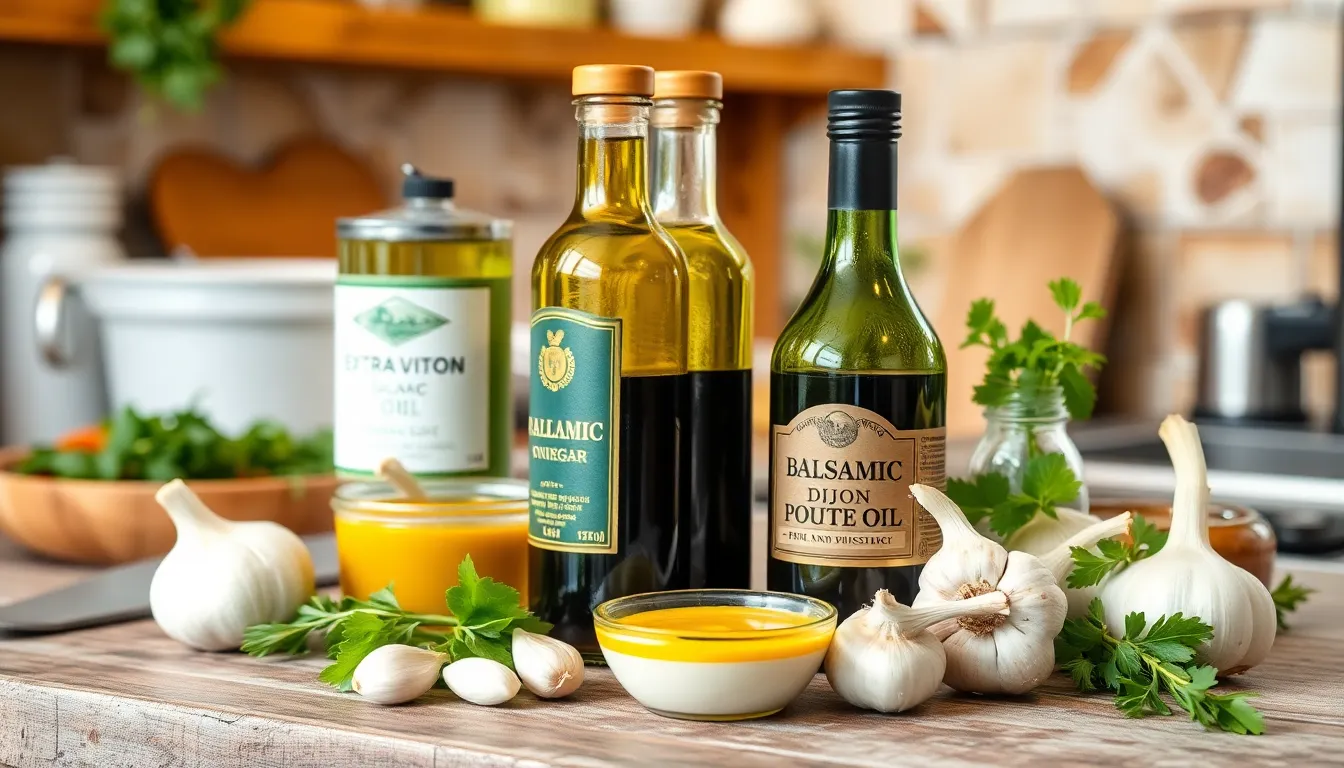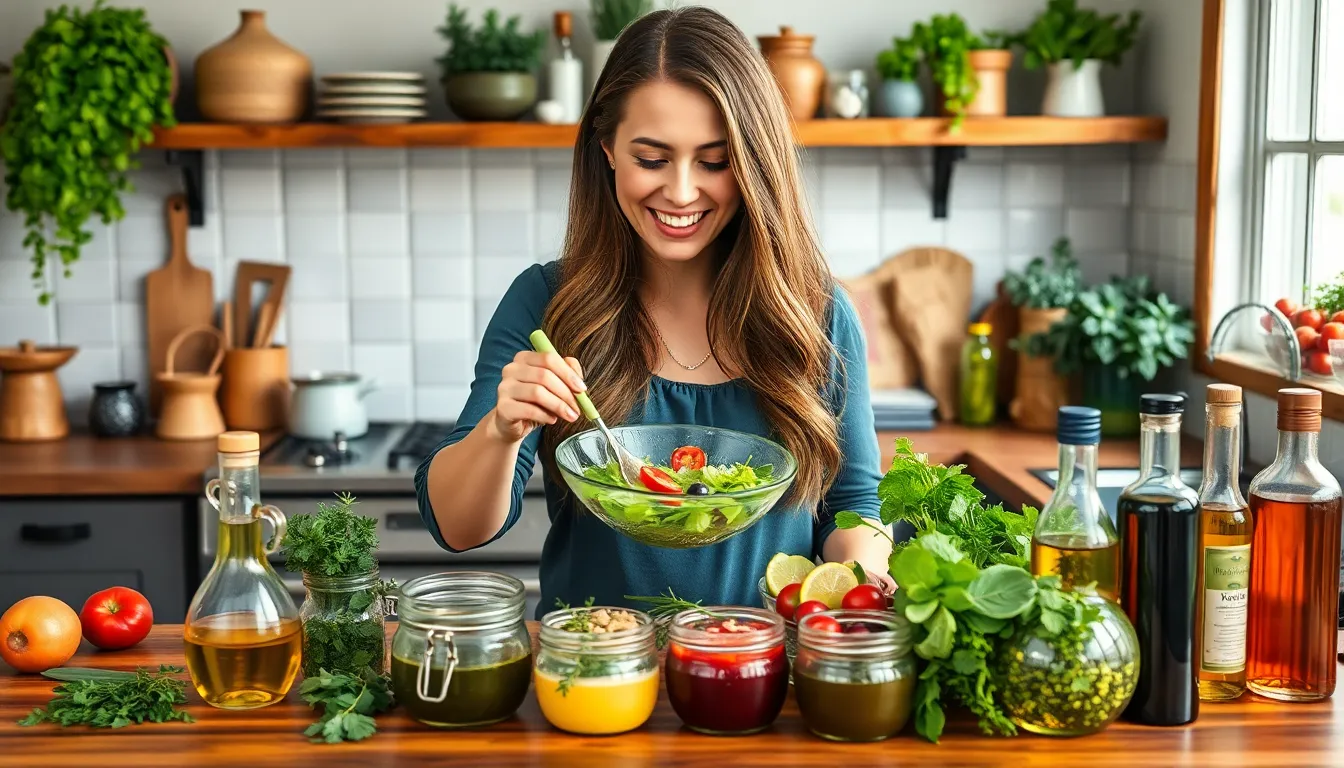Table of Contents
ToggleThere’s something special about homemade salad dressings that store-bought varieties just can’t match. With a few simple ingredients, anyone can whip up delicious and healthy dressings that elevate any salad from ordinary to extraordinary. Whether it’s a zesty vinaigrette or a creamy ranch, homemade dressings offer a burst of flavor while allowing for customization to suit personal tastes.
In a world increasingly focused on health and wellness, making salad dressings at home not only ensures freshness but also eliminates preservatives and additives. It’s a fun culinary adventure that encourages creativity in the kitchen. Dive into the world of homemade salad dressings and discover how easy it is to enhance your meals with vibrant flavors and wholesome ingredients.
Benefits Of Homemade Salad Dressings
Homemade salad dressings offer significant advantages, primarily concerning health and customization. These dressings enhance meal quality by allowing for nutritious, flavorful options tailored to individual preferences.
Healthier Ingredients
Homemade salad dressings contain fresher, nutrient-dense ingredients compared to commercial varieties. Individuals can select high-quality oils, organic herbs, and natural sweeteners, avoiding unhealthy additives and preservatives. For example, olive oil provides healthy fats, while vinegar boosts beneficial properties. Making dressings allows control over the calorie count and ingredient quality, promoting a healthier overall diet.
Customizable Flavors
Homemade dressings cater to personal taste preferences and dietary needs. Individuals can mix unique combinations of herbs, spices, and acids to create an original flavor profile. For instance, adding garlic or honey can create a unique vinaigrette; incorporating citrus enhances brightness. Customization ensures each meal remains exciting and enjoyable while meeting specific dietary restrictions or lifestyle choices.
Common Ingredients For Homemade Salad Dressings

Creating homemade salad dressings involves a variety of essential ingredients that enhance flavor and nutrition. Understanding these components makes the dressing-making process straightforward.
Oils
- Extra Virgin Olive Oil: This oil provides a rich, fruity flavor and healthy fats. It’s often used as a base for vinaigrettes due to its high antioxidant content.
- Avocado Oil: Known for its mild taste and high smoke point, avocado oil offers heart-healthy benefits and adds a smooth texture to dressings.
- Walnut Oil: This oil has a nutty flavor that complements salads featuring greens and fruits. It’s rich in omega-3 fatty acids, promoting heart health.
- Sesame Oil: Often used in Asian-style dressings, sesame oil introduces a unique aroma and flavor, enhancing recipes with an Asian flair.
Vinegars
- Balsamic Vinegar: This vinegar provides a sweet and tangy taste, making it a popular choice for salads with fruits, nuts, and cheese. Its complexity adds depth to dressings.
- Apple Cider Vinegar: Known for its health benefits, apple cider vinegar imparts a tangy flavor and pairs well with sweet ingredients like honey or maple syrup.
- Red Wine Vinegar: This vinegar offers a sharp acidity that brightens dressings. It’s ideal for Mediterranean-style salads featuring robust greens.
- Rice Vinegar: With a milder flavor profile, rice vinegar works well in lighter dressings. It’s commonly used in Asian-inspired recipes.
Aromatics and Spices
- Garlic: Fresh or roasted garlic adds depth and complexity to dressings. It pairs well with oils and acids, elevating overall flavor.
- Shallots: Milder than onions, shallots provide a subtle sweetness and mix well with vinegar and oil for a balanced dressing.
- Dijon Mustard: This ingredient helps emulsify dressings, creating a smooth texture. Its sharpness complements many types of oils and vinegars.
- Fresh Herbs: Basil, parsley, cilantro, and oregano bring vibrant flavors. Fresh herbs can transform simple dressings into flavorful companions for a variety of salads.
- Pepper: Freshly cracked black pepper enhances dressings with heat and complexity, balancing the flavors of oil and vinegar.
Popular Homemade Salad Dressing Recipes
Homemade salad dressings offer an array of flavors and textures. Here are some popular recipes that can enhance your salads.
Classic Vinaigrette
Classic vinaigrette presents a simple, versatile option for a variety of salads. This dressing combines three key ingredients: oil, vinegar, and seasoning. A basic ratio of 3:1 oil to vinegar ensures a balanced flavor.
Ingredients:
- 3 parts extra virgin olive oil
- 1 part balsamic or red wine vinegar
- Salt and pepper to taste
- Optional: minced garlic or Dijon mustard
Instructions:
- Mix oil and vinegar in a jar.
- Add salt, pepper, and optional ingredients.
- Shake until well combined.
Creamy Ranch Dressing
Creamy ranch dressing delivers a rich and tangy flavor. It’s perfect for both salads and as a dip. This dressing blends buttermilk with fresh herbs for a full taste profile.
Ingredients:
- 1 cup buttermilk
- ½ cup mayonnaise
- ¼ cup sour cream
- 1 teaspoon garlic powder
- 1 teaspoon onion powder
- Fresh parsley and chives, chopped
- Salt and pepper to taste
Instructions:
- Whisk buttermilk, mayonnaise, and sour cream in a bowl.
- Stir in garlic and onion powders, then add chopped herbs.
- Season with salt and pepper.
Lemon Tahini Dressing
Lemon tahini dressing offers a creamy yet light alternative. Its nutty flavor pairs well with greens and grains.
Ingredients:
- ¼ cup tahini
- ¼ cup water
- 2 tablespoons lemon juice
- 1 clove garlic, minced
- Salt to taste
Instructions:
- Whisk tahini and water until smooth.
- Add lemon juice and minced garlic.
- Season with salt, adjusting consistency with water if necessary.
These recipes deliver fresh, customizable options that enhance salads while prioritizing flavor and health.
Tips For Storing Homemade Salad Dressings
Storing homemade salad dressings properly ensures their freshness and flavor longevity. Adopting the right practices can enhance the overall experience of using these delicious dressings.
Proper Containers
Use airtight glass containers for optimal storage of homemade salad dressings. Glass is non-reactive and preserves the flavor better than plastic. Select containers with wide mouths for easy pouring and cleaning. Consider labeling containers with the dressing name and date made to maintain organization and freshness. Using smaller containers allows for portion control, reducing the likelihood of spoilage.
Shelf Life Considerations
Understand the shelf life of each dressing type to maintain quality. Vinaigrettes can last up to two weeks in the refrigerator due to their acidity. Cream-based dressings typically last around five days because of perishable ingredients like dairy. For best results, store dressings in a cool, dark area before opening and refrigerate promptly after use. Check for changes in smell, texture, or color, which may indicate spoilage, and discard any questionable dressings immediately.
Homemade salad dressings offer a delightful way to elevate meals while prioritizing health and flavor. By using fresh ingredients and customizing recipes, anyone can create dressings that cater to personal tastes and dietary needs. The versatility of oils, vinegars, and spices opens the door to endless flavor combinations that can transform even the simplest salads into gourmet experiences.
With a few essential ingredients and a little creativity, making dressings at home becomes an enjoyable culinary adventure. Storing these dressings properly ensures they remain fresh and flavorful, ready to enhance any dish. Embracing homemade salad dressings not only enriches meals but also empowers individuals to take control of their nutrition and enjoy the process of cooking.







